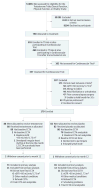Testosterone Treatment and Coronary Artery Plaque Volume in Older Men With Low Testosterone
- PMID: 28241355
- PMCID: PMC5465430
- DOI: 10.1001/jama.2016.21043
Testosterone Treatment and Coronary Artery Plaque Volume in Older Men With Low Testosterone
Abstract
Importance: Recent studies have yielded conflicting results as to whether testosterone treatment increases cardiovascular risk.
Objective: To test the hypothesis that testosterone treatment of older men with low testosterone slows progression of noncalcified coronary artery plaque volume.
Design, setting, and participants: Double-blinded, placebo-controlled trial at 9 academic medical centers in the United States. The participants were 170 of 788 men aged 65 years or older with an average of 2 serum testosterone levels lower than 275 ng/dL (82 men assigned to placebo, 88 to testosterone) and symptoms suggestive of hypogonadism who were enrolled in the Testosterone Trials between June 24, 2010, and June 9, 2014.
Intervention: Testosterone gel, with the dose adjusted to maintain the testosterone level in the normal range for young men, or placebo gel for 12 months.
Main outcomes and measures: The primary outcome was noncalcified coronary artery plaque volume, as determined by coronary computed tomographic angiography. Secondary outcomes included total coronary artery plaque volume and coronary artery calcium score (range of 0 to >400 Agatston units, with higher values indicating more severe atherosclerosis).
Results: Of 170 men who were enrolled, 138 (73 receiving testosterone treatment and 65 receiving placebo) completed the study and were available for the primary analysis. Among the 138 men, the mean (SD) age was 71.2 (5.7) years, and 81% were white. At baseline, 70 men (50.7%) had a coronary artery calcification score higher than 300 Agatston units, reflecting severe atherosclerosis. For the primary outcome, testosterone treatment compared with placebo was associated with a significantly greater increase in noncalcified plaque volume from baseline to 12 months (from median values of 204 mm3 to 232 mm3 vs 317 mm3 to 325 mm3, respectively; estimated difference, 41 mm3; 95% CI, 14 to 67 mm3; P = .003). For the secondary outcomes, the median total plaque volume increased from baseline to 12 months from 272 mm3 to 318 mm3 in the testosterone group vs from 499 mm3 to 541 mm3 in the placebo group (estimated difference, 47 mm3; 95% CI, 13 to 80 mm3; P = .006), and the median coronary artery calcification score changed from 255 to 244 Agatston units in the testosterone group vs 494 to 503 Agatston units in the placebo group (estimated difference, -27 Agatston units; 95% CI, -80 to 26 Agatston units). No major adverse cardiovascular events occurred in either group.
Conclusions and relevance: Among older men with symptomatic hypogonadism, treatment with testosterone gel for 1 year compared with placebo was associated with a significantly greater increase in coronary artery noncalcified plaque volume, as measured by coronary computed tomographic angiography. Larger studies are needed to understand the clinical implications of this finding.
Trial registration: clinicaltrials.gov Identifier: NCT00799617.
Conflict of interest statement
Figures
Comment in
-
Testosterone and Male Aging: Faltering Hope for Rejuvenation.JAMA. 2017 Feb 21;317(7):699-701. doi: 10.1001/jama.2017.0129. JAMA. 2017. PMID: 28241336 No abstract available.
-
Gegen das Altern hilft auch kein Testosteron.MMW Fortschr Med. 2017 May;159(8):42. doi: 10.1007/s15006-017-9573-x. MMW Fortschr Med. 2017. PMID: 28466321 German. No abstract available.
-
Testosterone treatment in older men: glass half empty or half full?Asian J Androl. 2017 Sep-Oct;19(5):512-514. doi: 10.4103/aja.aja_14_17. Asian J Androl. 2017. PMID: 28566558 Free PMC article.
-
Changes in Coronary Artery Plaque With Testosterone Therapy.JAMA. 2017 Jun 20;317(23):2450. doi: 10.1001/jama.2017.6016. JAMA. 2017. PMID: 28632859 No abstract available.
-
Cardiovascular benefits and risks of testosterone replacement: another warning?Cardiovasc Res. 2017 Sep 1;113(11):e38-e39. doi: 10.1093/cvr/cvx143. Cardiovasc Res. 2017. PMID: 28859305 No abstract available.
-
Re: Testosterone Treatment and Coronary Artery Plaque Volume in Older Men with Low Testosterone.J Urol. 2017 Oct;198(4):727-728. doi: 10.1016/j.juro.2017.07.057. Epub 2017 Jul 19. J Urol. 2017. PMID: 28905758 No abstract available.
References
-
- Barrett-Connor E, Khaw KT. Endogenous sex hormones and cardiovascular disease in men: a prospective population-based study. Circulation. 1988;78(3):539–545. - PubMed
-
- Khaw KT, Dowsett M, Folkerd E, et al. Endogenous testosterone and mortality due to all causes, cardiovascular disease, and cancer in men: European Prospective Investigation Into Cancer in Norfolk (EPIC-Norfolk) prospective population study. Circulation. 2007;116(23):2694–2701. - PubMed
-
- Oh JY, Barrett-Connor E, Wedick NM, Wingard DL Rancho Bernardo Study. Endogenous sex hormones and the development of type 2 diabetes in older men and women: the Rancho Bernardo Study. Diabetes Care. 2002;25(1):55–60. - PubMed
-
- Smith GD, Ben-Shlomo Y, Beswick A, Yarnell J, Lightman S, Elwood P. Cortisol, testosterone, and coronary heart disease: prospective evidence from the Caerphilly study. Circulation. 2005;112(3):332–340. - PubMed
Publication types
MeSH terms
Substances
Associated data
Grants and funding
LinkOut - more resources
Full Text Sources
Other Literature Sources
Medical


